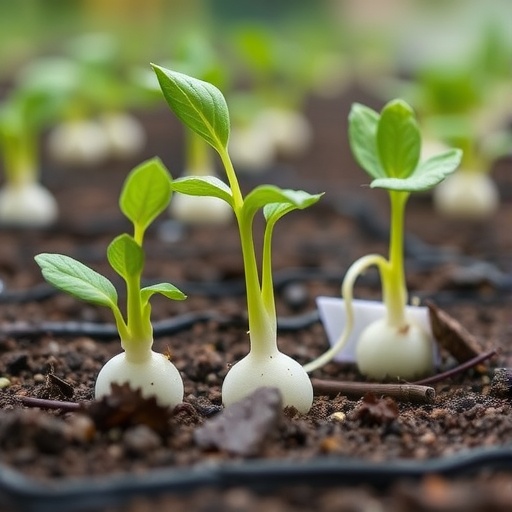In a groundbreaking study that sheds light on the intersection of plasma physics and agricultural science, researchers Kawano et al. have delved deep into the unique effects of discharge electrode materials on the germination of radish sprouts when utilizing cavitation bubble plasma-treated water. This cutting-edge research, published in the journal Discover Plants, addresses an intriguing area of inquiry that combines advanced technology with practical applications in the world of plant biology.
At the heart of the study is the innovative use of cavitation bubble plasma, a technology that harnesses high-energy discharge to create bubbles in water that, when imploded, generate powerful shockwaves and extreme conditions. These conditions produce a range of reactive species, which can significantly influence biological processes. The research team focused specifically on how the material composition of discharge electrodes could alter the physicochemical properties of the treated water, ultimately affecting seed germination.
The phenomenon of cavitation itself is fascinating. It occurs when vapor bubbles in a liquid collapse and generate localized high temperatures and pressures. The research team explored how this process, combined with plasma generation, could facilitate a more favorable environment for plant growth. By altering the electrode material, the scientists hypothesized they could modify the kinds and concentrations of reactive species produced during treatment, thus enhancing the treatment’s efficacy for agricultural applications.
In order to carry out the experiments, the researchers utilized various electrode materials, including metal types such as stainless steel and aluminum, to determine their effectiveness in ensuring optimal germination rates for radish seeds. Each material’s interactions with the processes of cavitation and plasma generation were meticulously analyzed. This attention to detail is crucial, as even minor variations in electrode materials can lead to significant differences in the outcomes of the treatment process.
The study’s methodology involved treating water with different electrode materials to create cavitation bubble plasma under controlled conditions. This water was then used for radish seed germination tests. Notably, the team recorded germination rates, seedling growth metrics, and other physiological responses to gauge the impact of the plasma-treated water on plant development. Such rigorous analysis sets the stage for harnessing advanced technologies to improve agricultural practices and food production.
Results from the experiments yielded promising results. Specifically, radish seeds exposed to water treated with certain electrode materials exhibited markedly higher germination rates compared to control groups that had not undergone treatment. This observation suggests that the chemical alterations induced by the cavitation bubble plasma are indeed favorable for germination and could potentially be replicated across various crop species.
Furthermore, the researchers extended their analysis beyond germination rates. They measured other vital indicators such as root length, leaf development, and overall plant health. The findings indicated a holistic enhancement in growth metrics for those seeds treated with optimal cavitation bubble plasma conditions, encouraging further exploration into the scalability of such treatments for larger agricultural systems.
What makes this study particularly intriguing is the potential for agricultural innovation it hints at. As global food demands increase, the need for efficient, sustainable farming methods becomes imperative. The introduction of plasma treatments, especially those tailored through various electrode materials, presents a novel approach to crop enhancement with a focus on environmental sustainability. This technique involves no harsh chemicals while leveraging advanced scientific principles to promote growth and health in plants.
Moreover, the implications extend beyond just radish sprouts. By understanding the interaction of different electrode materials, researchers can branch into a multitude of crops, aiming to improve their yields using similar plasma-treated water methods. This research creates a foundation for future studies that could revolutionize how we approach crop production in various environmental conditions, arguably allowing for year-round cultivation.
The significance of the findings also raises questions about the fundamental mechanisms at play during plasma-mediated treatments. The chemistry involved, particularly regarding the generation of reactive oxygen and nitrogen species, could lead to unparalleled insights into plant responses under stress conditions. This aligns with a growing field of research focusing on enhancing plant resilience through innovative treatments that mimic natural stressors, fostering adaptive growth processes.
Moreover, caution must be exercised when interpreting the results of such studies. While the findings are certainly promising, the intricacies of how different variables influence outcomes mean that future research will need to delve deeper. Variables such as water pH, electric field strength, and treatment duration all play pivotal roles and must be systematically evaluated in subsequent experiments to refine the treatment protocols for practical agricultural applications.
In conclusion, this research by Kawano et al. not only marks a significant advancement in our understanding of plant biology but also exemplifies the unique convergence of materials science and agriculture. As scientists continue to explore the myriad possibilities surrounding cavitation bubble plasma and electrode materials, we stand on the brink of possibly transforming traditional farming practices into more efficient, environmentally friendly alternatives. This study opens the door to a future where science and agriculture work hand-in-hand to devise innovative solutions for global food challenges.
The implications of this work are vast, suggesting that integrating high-tech processes into agriculture could lead to not just improved yields but also breakthroughs in how we approach planting, nurturing, and harvesting crops for generations to come. Continuous research in this field will be crucial for translating these laboratory findings into actionable agricultural technologies.
The potential for practical applications of this technology in agriculture encompasses a wide range of crops and could stimulate interest in further innovations in plant growth treatments. As we endeavor to meet the challenges posed by an increasing global population and changing environmental conditions, research such as this will undoubtedly play a pivotal role in shaping the future of sustainable agriculture.
In summary, the exploration of discharge electrode materials in conjunction with cavitation bubble plasma represents a fascinating frontier in agricultural science. As we move forward, awareness and understanding of such advanced techniques will be essential in navigating the complexities of future food systems, underscoring the importance of interdisciplinary collaboration in research and biotechnology applications.
Subject of Research: Effect of discharge electrode material on germination of radish sprout using cavitation bubble plasma treated water.
Article Title: Effect of discharge electrode material on germination of radish sprout using cavitation bubble plasma treated water.
Article References:
Kawano, K., Nukina, S., Eguchi, K. et al. Effect of discharge electrode material on germination of radish sprout using cavitation bubble plasma treated water.
Discov. Plants 2, 269 (2025). https://doi.org/10.1007/s44372-025-00349-3
Image Credits: AI Generated
DOI: 10.1007/s44372-025-00349-3
Keywords: Cavitation bubble plasma, discharge electrode materials, radish germination, plant biology, sustainable agriculture.
Tags: advanced technology in plant growthcavitation bubble plasma technologyelectrode materials for plasma treatmentexperiments in germination conditionsimpact of plasma physics on agricultureimplications of electrode compositioninnovative agricultural techniquesintersection of science and agriculturephysicochemical properties of treated waterradish seed germination effectsreactive species in plant biologyshockwave influence on seeds






